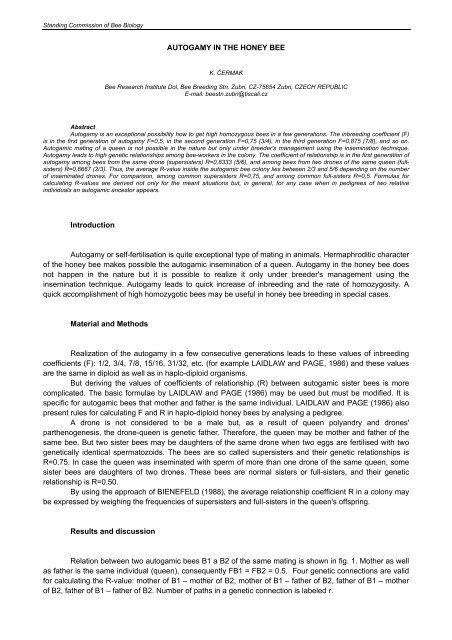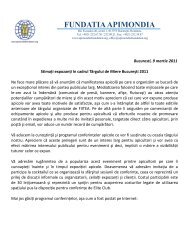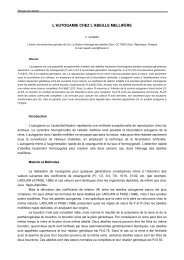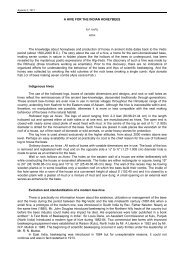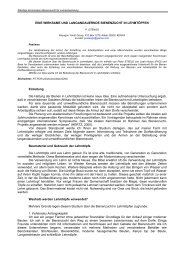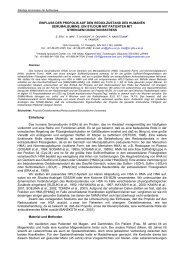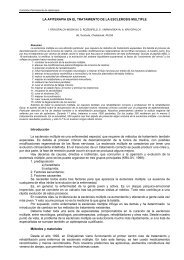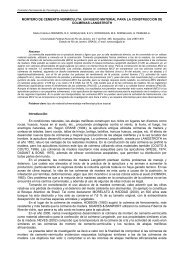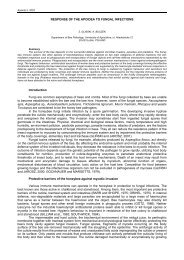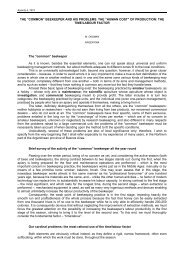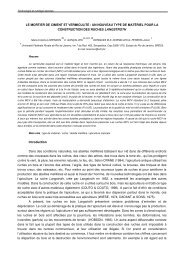AUTOGAMY IN THE HONEY BEE Introduction ... - Apimondia
AUTOGAMY IN THE HONEY BEE Introduction ... - Apimondia
AUTOGAMY IN THE HONEY BEE Introduction ... - Apimondia
Create successful ePaper yourself
Turn your PDF publications into a flip-book with our unique Google optimized e-Paper software.
Standing Commission of Bee Biology<br />
<strong>AUTOGAMY</strong> <strong>IN</strong> <strong>THE</strong> <strong>HONEY</strong> <strong>BEE</strong><br />
K. ČERMAK<br />
Bee Research Institute Dol, Bee Breeding Stn. Zubri, CZ-75654 Zubri, CZECH REPUBLIC<br />
E-mail: beestn.zubri@tiscali.cz<br />
Abstract<br />
Autogamy is an exceptional possibility how to get high homozygous bees in a few generations. The inbreeding coefficient (F)<br />
is in the first generation of autogamy F=0,5, in the second generation F=0,75 (3/4), in the third generation F=0,875 (7/8), and so on.<br />
Autogamic mating of a queen is not possible in the nature but only under breeder's management using the insemination technique.<br />
Autogamy leads to high genetic relationships among bee-workers in the colony. The coefficient of relationship is in the first generation of<br />
autogamy among bees from the same drone (supersisters) R=0,8333 (5/6), and among bees from two drones of the same queen (fullsisters)<br />
R=0,6667 (2/3). Thus, the average R-value inside the autogamic bee colony lies between 2/3 and 5/6 depending on the number<br />
of inseminated drones. For comparison, among common supersisters R=0,75, and among common full-sisters R=0,5. Formulas for<br />
calculating R-values are derived not only for the meant situations but, in general, for any case when in pedigrees of two relative<br />
individuals an autogamic ancestor appears.<br />
<strong>Introduction</strong><br />
Autogamy or self-fertilisation is quite exceptional type of mating in animals. Hermaphroditic character<br />
of the honey bee makes possible the autogamic insemination of a queen. Autogamy in the honey bee does<br />
not happen in the nature but it is possible to realize it only under breeder's management using the<br />
insemination technique. Autogamy leads to quick increase of inbreeding and the rate of homozygosity. A<br />
quick accomplishment of high homozygotic bees may be useful in honey bee breeding in special cases.<br />
Material and Methods<br />
Realization of the autogamy in a few consecutive generations leads to these values of inbreeding<br />
coefficients (F): 1/2, 3/4, 7/8, 15/16, 31/32, etc. (for example LAIDLAW and PAGE, 1986) and these values<br />
are the same in diploid as well as in haplo-diploid organisms.<br />
But deriving the values of coefficients of relationship (R) between autogamic sister bees is more<br />
complicated. The basic formulae by LAIDLAW and PAGE (1986) may be used but must be modified. It is<br />
specific for autogamic bees that mother and father is the same individual. LAIDLAW and PAGE (1986) also<br />
present rules for calculating F and R in haplo-diploid honey bees by analysing a pedigree.<br />
A drone is not considered to be a male but, as a result of queen polyandry and drones'<br />
parthenogenesis, the drone-queen is genetic father. Therefore, the queen may be mother and father of the<br />
same bee. But two sister bees may be daughters of the same drone when two eggs are fertilised with two<br />
genetically identical spermatozoids. The bees are so called supersisters and their genetic relationships is<br />
R=0.75. In case the queen was inseminated with sperm of more than one drone of the same queen, some<br />
sister bees are daughters of two drones. These bees are normal sisters or full-sisters, and their genetic<br />
relationship is R=0.50.<br />
By using the approach of BIENEFELD (1988), the average relationship coefficient R in a colony may<br />
be expressed by weighing the frequencies of supersisters and full-sisters in the queen's offspring.<br />
Results and discussion<br />
Relation between two autogamic bees B1 a B2 of the same mating is shown in fig. 1. Mother as well<br />
as father is the same individual (queen), consequently FB1 = FB2 = 0.5. Four genetic connections are valid<br />
for calculating the R-value: mother of B1 – mother of B2, mother of B1 – father of B2, father of B1 – mother<br />
of B2, father of B1 – father of B2. Number of paths in a genetic connection is labeled r.
Standing Commission of Bee Biology<br />
Figure 1 - Relationship coefficient R of two autogamic bees.<br />
The full line represents the path between mother and daughter, the dashed line the path between father and daughter.<br />
Autogamic sisters from two drones<br />
Each of four genetic connections (fig. 1) is composed of two paths (r=2), each path has the value<br />
0.5, therefore each genetic connection has the value 0.52.<br />
In case the queen Q is not inbred (FQ=0), R is:<br />
R<br />
4 × 0.5<br />
( 1+<br />
F ) × ( 1+<br />
F )<br />
B1<br />
B2<br />
1 2<br />
= =<br />
1.5 3<br />
2<br />
B1, B2<br />
=<br />
=<br />
0.6667<br />
In case the queen Q is inbred (FQ>0), FB1=FB2=0.5×(1+FQ), and R is:<br />
R<br />
B1,B2<br />
=<br />
4 × 0.5<br />
2<br />
( 1+<br />
F )<br />
( 1+<br />
F ) × ( 1+<br />
F ) 3 + FQ<br />
B1<br />
×<br />
Q<br />
B2<br />
2 + 2 × F<br />
=<br />
Q<br />
(1)<br />
(2)<br />
Autogamic sisters from the same drone (from two genetically identical spermatozoids)<br />
Genetic connection father of B1 – father of B2 is composed of two paths, each of the value √0.5,<br />
therefore 0.5 is set in the formula for this connection. The other three genetic connections have the value<br />
0.52.<br />
In case the queen Q is not inbred (FQ=0), R is:<br />
2<br />
3×<br />
0.5 + 0.5 1.25 5<br />
R B1, B2 =<br />
= = = 0.8333<br />
1+<br />
F × 1+<br />
F 1.5 6<br />
( ) ( )<br />
B1<br />
B2<br />
(3)<br />
In case the queen Q is inbred (FQ>0), FB1=FB2=0.5×(1+FQ). Because haploid drone represents the<br />
father, his F-value is not present in the formula as Fdrone=0. Thus, R is:<br />
R<br />
B1,B2<br />
3×<br />
0.5<br />
=<br />
2<br />
×<br />
( 1+<br />
F )<br />
( 1+<br />
F ) × ( 1+<br />
F ) 6 + 2 × FQ<br />
B1<br />
Q<br />
+ 0.5 5 + 3×<br />
F<br />
=<br />
B2<br />
Q<br />
(4)
Standing Commission of Bee Biology<br />
Average relationship inside the colony of autogamically inseminated queen<br />
The average R-value is calculated by weighing the formulas (1) and (3) in case FQ=0, or formulas<br />
(2) a (4) in case FQ>0, with the frequencies of subfamilies by drones in the colony (d). The size of single<br />
subfamilies is supposed to be the same.<br />
If FQ=0:<br />
⎛ d −1<br />
2 ⎞ ⎛ 1 5 ⎞<br />
R = ⎜ × ⎟ + ⎜ × ⎟<br />
⎝ d 3 ⎠ ⎝ d 6 ⎠<br />
(5)<br />
If FQ>0 :<br />
⎛<br />
⎜<br />
d −1<br />
2 + 2×<br />
F<br />
R = ×<br />
⎝ d 3 + FQ<br />
The general formula:<br />
4 × 0.5 ×<br />
R =<br />
r<br />
Q<br />
⎞ ⎛ + ×<br />
⎟ ⎜<br />
1 5 3 F<br />
+ ×<br />
⎠ ⎝ d 6 + 2×<br />
F<br />
r<br />
( 1+<br />
F ) × ( d −1 )/d<br />
+ 0.5 × ( 5 + 3×<br />
F )<br />
Q<br />
Q<br />
Q<br />
( 1+<br />
F ) × ( 1+<br />
F )<br />
B1<br />
B2<br />
⎞<br />
⎟<br />
⎠<br />
Q<br />
/d<br />
(6)<br />
(7)<br />
R E F E R E N C E S<br />
Bienenfeld K. (1988), Vererbung von Leistungseigenschaften bei der Honigbiene. Dissertation. Univ. München, 159 pp.<br />
Laidlaw H.H., Page R.E. (1986), Mating systems. In: Bee Genetics and Breeding, Academic Press. Inc., ed. T.E. Rinderer, pp. 323-344


